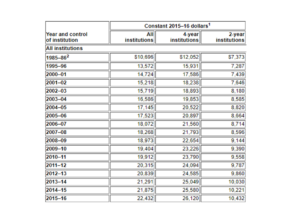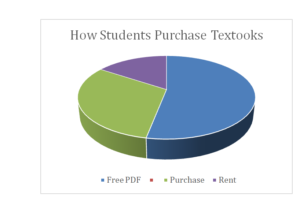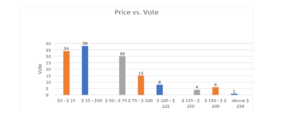The Student Dream:
A Subscription-Based Textbook Service for College Students
Inkless
Erik Jimenez, Anderson Tan, Ratul Bin Rasul, Shageldi Gaylyyev
Due Date: 11/13/18
Introduction
At the beginning of every semester, some professors may ask their students to bring the required textbooks to every class. The issue of forgetting the textbook at home or the textbook being too heavy to carry is problematic to both students and professors that use these resources for the class. Now imagine paying a minimal fee for an entire library of college textbooks accessible through an app. Not only will this help resolve the problem of having the required textbooks with you all the time, it can help stabilize financial situations that some students may struggle upon.
Students have been struggling to pay for tuition in addition to college resources for many generations. Despite of all the eligible financial aid, the cost of education is still increasing exponentially. According to the National Center for Education Statistics, it states that “Between 2005–06 and 2015–16, prices for undergraduate tuition, fees, room, and board at public institutions rose 34 percent, and prices at private nonprofit institutions rose 26 percent, after adjustment for inflation.”
Fig. 1 – Average total tuition, fees, room and board rates charged for full-time undergraduate students in degree-granting institutions.
Because of financial difficulties, students are turning to alternative means such as online portable document formats or known as pdfs. It is harder now to see the value of a physical textbook as it is costly impractical after the semester ends. Therefore, we want to solve this issue by proposing the Inkless Project to all students within the City College of New York and potentially to other campuses as well. This project will insure that all college textbooks will be available in this up-to-date app with only a subscription fee, paid each semester, for every verified student. Since textbooks are part of every curriculum, these portable textbooks will be accessible anywhere at any time.
Action Plan
Step 1: Conduct a survey on campus that will inform us whether or not students would support our idea of a textbook service that is subscription-based.
Step 2: After receiving enough votes supporting the idea, contact the President of the City College of New York to see if he would support the idea as well.
Step 3: If they agree, email and speak with a representative from the CCNY online bookstore and arrange a meeting to convey our ideas to them.
Step 4: After the online bookstore agrees, we will begin our process by collaborating with them and setting up a meeting to discuss how to further approach this idea.
Step 5: Propose idea of getting an investor to support the textbook subscription idea so that we can have the finances for all college textbook PDF’s.
Step 6: After getting an investor on board, begin the development of a website that will hold all of these textbooks. There are different options for this. For one option, a domain (.com/.org) is needed which is about $10-15 annually. It can be created on WordPress or Magento which is more sophisticated. The second option requires a developer which would cost $40 per hour. This will lead to about two to three months needed for all of the data to be entered into the website.
Step 7: Begin the creation of an app available on Apple IOS and Android. A sign-in will be required and they will be able to download the book and access it without internet. An app like this will cost $48,000.
Step 8: Throughout these steps, spread the word of the website and app so that students understand and are able to use it.
Cost & Benefits
The National Association of College Stores (NACS) says the average college student will spend $655 on textbooks each year, but with a single textbook easily costing as much as $300, that total can be much higher. The College Board puts the annual cost of books and materials at $1,168. Therefore, assuming the student completes two semesters annually the student will spend almost $600 per semester.
Surprisingly about one-fifth of a textbook’s price goes to the store where it is sold to cover personnel and operating costs, while more than three-quarters goes straight to the publisher, according to a recent article from U.S. News & World Report. Thus, this business model will appease the publishers, but incite the students. However, like all revolutions the digital revolution of the internet era demands changes, even in the academic publishing sector.
In a survey out of 115 students at CCNY, 36 students would rather purchase their textbooks, 18 would rent, and 61 students would rather find a free PDF version.
Fig. 2 – The pie chart displays how students usually get their textbooks.
The number of students downloading free PDFs constitutes at least 53% of the students. CCNY has a total of 16,516 students with 11,008 of them being full time, putting together all the calculations an astounding $10.5 million worth of textbook sales is lost to pirated copies of annually. An interesting fact from the survey that can put this into perspective is that 76 students out of 115 have found at least 3 textbooks for free this semester, that is, 66% of the students. So, the total value of the pirated textbooks would actually be more than $10.5 million annually.
Inkless has come up with a solution to make this lost market potential available to benefit both students and publishers. A subscription-based business model with targeted pricing will greatly reduce the circulation of pirated content while increasing the revenue of the publishers. This model will attract students with many benefits too as a digital library. Some benefits include reasonable pricing, greater portability, accessibility through several device types, the security of complying with legal conduct and also an opportunity to give back to the world by reducing paper use which will help save trees.
Great, so what would be the best subscription price. To find a price that students would love to pay, we conducted a survey. Here is what we found:
Fig. 3 – Students asked on their preferred subscription price.
The highest price that got the most votes was $50 and the average of all the prices that students found reasonable was $60 per semester. So, a pricing of $59.99 is the perfect price which has 75% support of the survey. At this price, considering all students subscribe there would be a total revenue of $2 million annually. If 75% of the revenue is paid to the publishers of which there are 5 major ones for CCNY, there would be a net profit of $500,000 annually for Inkless. The cost of building an app and website along with web hosting would require an initial investment of $50,000. Inkless would break even and even make a profit of $450,000 (900%) within the first year. As for the students they would only be paying 10% of what they pay now for textbooks. This is a great business model benefitting all parties and making the world a better place while doing so. With more saved capital Inkless could expand in other educational dimensions and keep improving the quality of service and education.
Conclusion
In a nutshell, the purpose of this project is to make college textbooks affordable for CCNY students and make it beneficial for publishers at the same time. Our investigation shows that some students spend at least $100/semester for textbooks and most of the students find free PDFs online illegally which is worth of $10.5 million per year. By launching this project, students will only have to pay a subscription fee, $59.99, per semester to get all the required textbooks and publishers will be earning $1.75 million annually. Inkless will also have its fare share which is $450,000 per year. Besides financial benefits, this project will help to protect trees on earth.
Experience
Erik Jimenez is a current sophomore at The City College of New York with a major in mechanical engineering. He was work experience in Long Island which is where he lives. He worked at Staples where he earned a few “Employee of the Month” awards but would stop working there to focus on the end of his senior year in high school. That summer he graduated, he began to work at a popular restaurant named Hudson’s located in the town he lives, which is Freeport. He feels he is a very hard worker and highly responsible when he has to get things done. He is also organized and respectful to everyone he meets. A few of his skills include math and being able to think creatively when it comes to problem-solving. He enjoys playing sports, watching t.v., and listening to music, preferably hip-hop.
Shageldi Gaylyyev is a 3rd year college student majoring in Mechanical engineering at CCNY. He is transferred form from NYCCT which is located in Brooklyn. Currently, he is doing a part time job as a manager in an online company. He thinks that he is responsible, hard working, honest and creative. He believes there is no problem that cannot be solved and in his job he has a skill to solve any kind of a problem.
Anderson Tan attended New York City College of Technology and recently transferred over to the City College of New York to finish his bachelor’s degree in computer science. He writes small programming codes using python which he had learned in his old school. Some of these projects include an identical version of a bank atm (automated teller machine) and simple arithmetic calculators. His education in City College has encouraged him to learn new languages, such as C++ and Java, to potentially develop apps, games and to use it for other administrative tasks. He is dependable and is sincere with his work and loves to overcome challenges that arise when it is least expected. His studies will, therefore, assist him into his future work in this field.
Ratul Bin Rasul is currently a second year Mechanical Engineer at CCNY. He recently immigrated to NY in 2018. A citizen of Bangladesh he was mostly brought up in one of the best missionary schools in India – St. Joseph’s School under Belgian Catholics in Darjeeling, a city near the Himalayas. He has worked for an Electronics Factory in Astoria and is currently employed by UBreakIFix Chain Retailers. Proficient in repair skills and an active communicator having participated in various national level debates, he plans to continue education but in Computer Science to express his creativity through the language of machines.
References
Fact vs. Fiction: 7 Truths about College Course Materials. (n.d.). Retrieved from https://publishers.org/our-markets/higher-education/fact-vs-fiction-7-truths-about-college-course-materials
Mesa, Tony. “What Do I Need To Build A Website?” (2018, June 12). Retrieved from www.pickaweb.co.uk
Silverman Ed. City Facts Fall 2017. ( 2017, May). Retrieved from https://www.ccny.cuny.edu/sites/default/files/institutionalresearch/upload/City_Facts_Fall_2017_WEB.pdf
The Boundless American Dream Scholarship for DACA & TPS Students. (n.d.). Retrieved from http://www.boundless.com/boundless-american-dream-scholarship/.
Top 20 Surprising Facts About College Today. (2017, February 14). Retrieved from http://www.susangreenecopywriter.com/articles/top-10-surprising-facts-about-college-today.html
Tuition Costs of Colleges and Universities (National Center for Education Statistics). (2018). Retrieved from https://nces.ed.gov/fastfacts/display.asp?id=76
Where Is the Netflix for College Textbooks? (2014, April 28). Retreived from www.huffingtonpost.com/dean-florez/where-is-the-netflix-for-_b_4849019.html.





